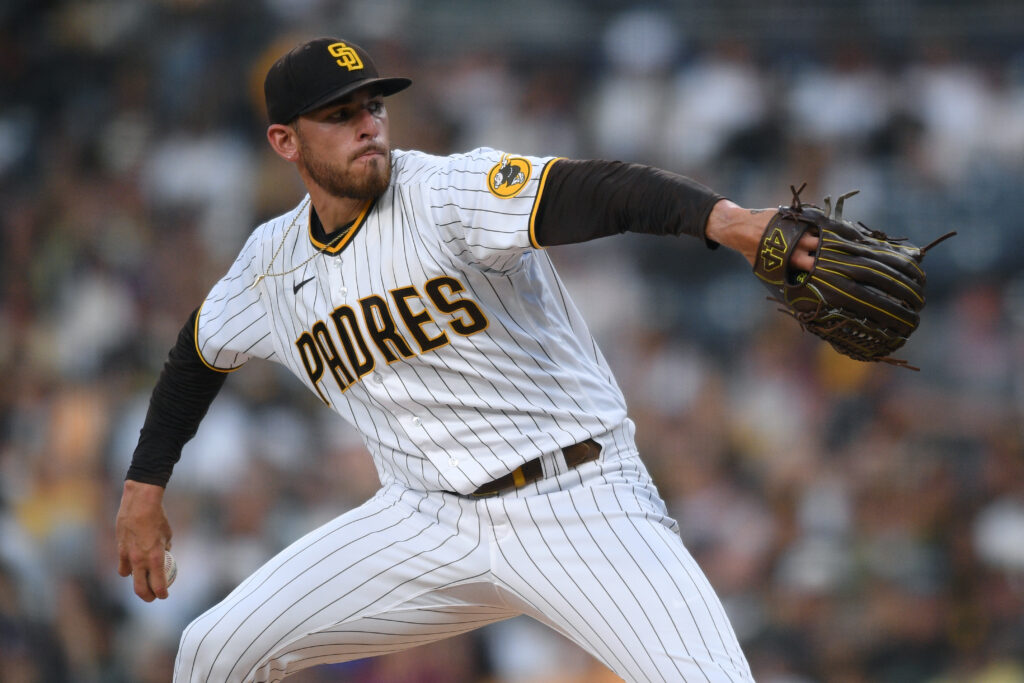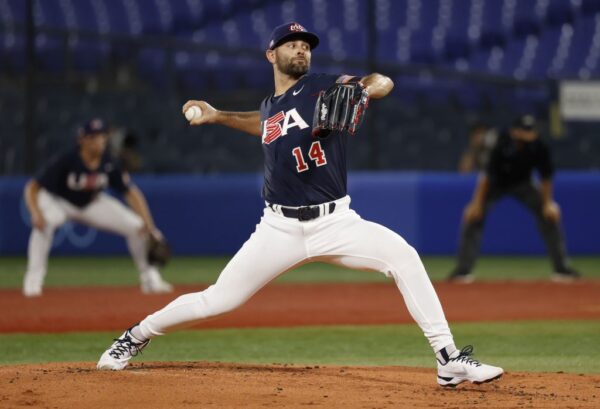Previewing the rotation for the 2022 San Diego Padres

Mandatory Credit: Orlando Ramirez-USA TODAY Sports

| Throws: Right | 6’4 215 pounds
2019 Stats: 126.0 IP, 2.71 ERA, 2.49 FIP, 1.056 WHIP, 6.9 H/9, 0.7 HR/9, 2.6 BB/9, 12.1 K/9, 4.1 bWAR, 4.5 fWAR
After being acquired in one of the biggest trades in Padres’ history, Mike Clevinger’s time as a Padre was cut short after Tommy John surgery in late 2020. Now back and throwing again, Clevinger looks to make an impact on the mound for the 2022 Padres.
When at full health, Clevinger’s fastball sits 93-98 mph and is complemented by a 79-84 mph slider, a 77-80 mph curveball, an 86-90 mph cutter, and an 85-89 mph changeup. Clevinger mixes these pitches well and put up the numbers of a frontline starter from 2017-2019 in Cleveland. While Clevinger was able to pitch over 200 innings in 2018, his 2017 and 2019 runs were both limited to under 130 innings due to injury, a common issue for Clevinger that culminated in Tommy John surgery last offseason. Two questions hang over Clevinger going into 2022: Will he be able to return to his former self, and how long will he be able to stay on the mound?
Mike Clevinger is a lock for a rotation spot in 2022, barring injury before Opening Day. While it’s a pipe dream, should Clevinger return with his 2019 stuff and his 2018 durability, he’d easily be the top pitcher on the Padres staff. The Padres can only hope that’s what they’ll get.
[wpedon id=”49075″ align=”right”]
| Throws: Right | 6’1 200 pounds
2021 Stats: 149.2 IP, 1.62 ERA, 1.029 WHIP, 6.9 H/9, 0.4 HR/9, 2.3 BB/9, 8.8 K/9
A product of the Texas Rangers farm system under current Padres general manager A.J. Preller, Martinez flew onto everyone’s radar in 2021 following a season where he surprisingly established himself as one of Japan’s top pitchers. Martinez agreed to a 4 year, $20 million contract with the San Diego Padres, but was unable to complete a physical prior to the lockout, making the deal unofficial as of now. It is, however, expected to be completed once the lockout is over.

Martinez’s breakout seems to be the product of mechanical changes he’s recently made to his delivery, including noticeably shortening his arm swing, a practice that has been successfully used by the likes of Shane Bieber, Lucas Giolito, and future teammate Joe Musgrove.
Speaking of Lucas Giolito, despite the obvious size difference, Giolito is an excellent comparison for the kind of stuff this new and improved Nick Martinez brings to the table. Previously sitting 89-94 mph, Martinez’s fastball now sits 91-96/97 MPH and is consistently pounded by Martinez at the top of the strike zone. This new and more powerful fastball sets up Martinez’s best pitch: a 79/80 mph changeup with plenty of deception and sink that tunnels perfectly with his fastball. Martinez also features a mid 80s slider and low 80s curveball to mix things up.
Martinez would likely be the favorite for the fifth spot in the Padres 2022 rotation when officially signed. While he obviously won’t see the dominance he did in Japan in the MLB, Martinez does possess the stuff of an MLB caliber starter. The best-case scenario could have a surprise season like former Padre Miles Mikolas did for the Cardinals in 2018 after returning from Japan. Worst case scenario, Martinez could end up like Merrill Kelly. The latter has been a dependable arm in the back of Arizona’s rotation for the past three seasons after returning from a stint in Korea. Regardless, Martinez is returning to MLB coming off of a much better season than either Mikolas or Kelly. Meanwhile possessing better stuff and will make for an interesting name to watch.
Chris Paddack
| Throws: Right | 6’5 217 pounds
2021 Stats: 108.1 IP, 5.07 ERA, 3.78 FIP, 1.265 WHIP, 9.6 H/9, 1.2 HR/9, 1.8 BB/9, 8.2 K/9, -0.8 bWAR, 1.8 fWAR
Following an impressive rookie campaign in 2019, Chris Paddack has since struggled to find his footing again in the two seasons since, despite flashes of dominance.

Paddack’s fastball sits anywhere from 91-98 mph, depending on the start, and is paired with his signature mid 80s changeup. This two-pitch mix dominated hitters in 2019 but has since been much easier for hitters to pick up. Paddack’s curveball and his struggles to consistently throw it have been the source of much debate in the baseball world over his career, with the narrative being that an improved curveball would be the key to Paddack reaching his potential as a number two starter. Paddack’s curveball was better than it ever has been in 2021, with its average velocity up from 76 to 78 MPH and statistically being Paddack’s most effective pitch, with opponents slugging .163 against it and it having a 36% whiff rate.
Like Darvish, part of Paddack’s problem seems to be the fact that he throws his least effective pitch a majority of the time. Opponents hit .314 and slugged .531 off of Paddack’s fastball in 2021, far worse marks than his changeup and curveball. Paddack threw his fastball 62% of the time as compared to throwing his changeup 26% and his curveball 12%. This is a bit more of a complicated case than that of Darvish, who would have a much easier time transitioning away from his cutter as his primary pitch as opposed to Paddack, who uses a more traditional fastball-heavy style. The best course of action may be to work the 62/26/12 split between his fastball, changeup, and curveball closer to a 50/35/15 split. It’s important to note that Paddack did post a career-best 3.78 FIP in 2021, an indicator that bad luck may have played a role in Paddack’s poor numbers.
Paddack’s damaged UCL may end up being an issue for him in 2022, and because of that and strong competition in Nick Martinez, Paddack may not see very much time in the rotation next year. Paddack’s high ceiling still remains, and it’s possible new pitching coach Ruben Niebla could help him finally reach it.
| Throws: Left | 6’1 230 pounds
2021 Stats: 94.2 IP, 5.32 ERA, 5.44 FIP, 1.384, 9.6 H/9, 1.9 HR/9, 2.9 BB/9, 6.8 K/9, -0.3 bWAR, -0.1 fWAR
After a strong start to 2021, the high FIP and poor peripherals that had been looming over Weathers’s storybook April caught up to him, leading to him finishing the season with an ERA and FIP both over five.

Weathers primarily throws a four-seam fastball that sits 92-97 mph, pairing it with a solid slider and changeup. A common issue that has been pointed out with Weathers’s arsenal is that he continued to use his four-seam fastball over his sinker, despite the latter being better suited for him. In 2021, opponents hit .340 and slugged .641 against his four-seam fastball while only hitting .257 and slugging .432 against his sinker. Much like Yu Darvish, it seems like switching his primary fastball in 2022 could be important for Weathers’s success going forward. Weathers did feature a very good slider which opponents only hit .217 and slugged .348 against.
As a former top ten draft pick and top 100 prospect, Weathers could break out at seemingly any moment and should be a great candidate to work with Ruben Niebla. An increase in sinker and slider usage could work in.
| Throws: Right | 6’2 205 pounds
2021 Stats: 29.0 IP, 4.97 ERA, 4.96 FIP, 1.483 WHIP, 7.1 H/9, 0.6 HR/9, 6.2 BB/9, 6.2 K/9, -0.2 bWAR, 0.0 fWAR
Called up to reinforce the Padres late in the season rotation, Knehr faltered with his command at the MLB level but still remains an intriguing option to provide innings in 2022.
Knehr’s fastball sat in the 92-96 mph range, being complemented by a firm yet effective changeup sitting 86-90 mph, an 87-91 mph cutter, and an 80-84 mph slider. Knehr’s signature fastball/changeup combo continued to be effective in MLB, with opponents hitting .167 and slugging .300 against his fastball and hitting .190 and slugging .381 against his changeup. Knehr’s cutter and slider proved far less effective against hitters, with opponents hitting .429 and slugging .571 against his cutter and hitting .333 and slugging .444 against his slider. Knehr’s most glaring issue was his very poor command, posting a 6.2 BB/9 that would make teammate Austin Adams proud. Fixing his command is a paramount issue for Knehr, whose primary pitch combo has already proved to be effective at the highest level.
Knehr will likely find himself starting in the Triple-A rotation, but is also a probable trade option for the Padres this offseason.
| Throws: Right | 6’2 215 pounds
2021 Stats: 125.0 IP, 3.38 ERA, 1.240 WHIP, 8.2 H/9, 0.7 HR/9, 3.0 BB/9, 8.8 K/9
Known as a longtime sleeper in the Padres system, Martinez dominated the Double-A competition after putting everything together in 2021.
Martinez sits 90-95 mph on his fastball, occasionally topping out at 96/97 MPH. Martinez’s changeup is the star of his arsenal, a low 80s offering that features a similar heavy screwball break to Devin Williams‘s “airbender.” Martinez had also shown an improved slider in the mid-80s that has become more effective. Martinez struggled in his callup to Triple-A but finished strong with a ten-strikeout performance and earned an early 40 man roster spot.
With arguably the best changeup in the Padres farm system, Martinez seems poised to see MLB action sooner rather than later.
MacKenzie Gore | Throws: Left | 6’2 197 pounds
2021 Stats: 50.1 IP, 3.93 ERA, 1.470 WHIP, 8.2 H/9, 0.5 HR/9, 5.0 BB/9, 10.9 K/9
Once the best pitching prospect in baseball, MacKenzie Gore took a major step back in 2021 with his highly publicized command issues.

At his best, MacKenzie Gore is a true pitching prodigy as a big left-hander with four-plus pitches. Gore’s fastball sits 93-98 mph and is paired with a high 80s slider, a low 80s curveball, and a mid 80s changeup. All of these pitches have flashed plus at times, giving Gore the frightening projection of Blake Snell with a better changeup.
While this optimal version of Gore has reared its head on occasion in 2021, his lack of consistent command has kept him from reaching the MLB level. There is hope that new pitching coach and mechanical specialist Ruben Niebla can get Gore back in the strike zone consistently and back on track to his ace level potential.
The Padres do have a few more options in their organization that will have an outside chance of making an impact in the 2022 rotation.
Moises Lugo, a 6’1, soon to be 23-year-old right-hander, posted a 3.19 ERA over 90.1 IP between High-A and Double-A. Lugo features a mid 90s fastball and mid 80s slider and posted an impressive 11.5 K/9.
Robert Gasser, another 6’1 soon to be 23 year old, who pitches from the left side, has already impressed with a 1.20 ERA in his first 15.0 IP between Rookie Ball and Single A. Gasser features a 90-96 mph fastball along with a slider and changeup in the mid-80s. All three pitches flash plus with plus command, giving Gasser all the necessary tools to be a quick riser in the Padres system.
Aaron Leasher, a left-hander and longtime Padres farmhand posted a 3.76 ERA between Double-A and Triple-A in 64.2 IP, flashing a mid 90s fastball and wipeout slider.
Luis Madrazo, a 22-year-old, 6’4 right-hander recently signed by the Padres out of the Dominican Republic, features a 93-95 mph fastball, a mid-80s slider, and both a changeup and splitter, giving him the stuff to potentially reach the big leagues in 2022.
Born and raised in San Diego, aspiring Baseball Journalist and lifelong fan of the San Diego Padres. My life’s goal is to retire early, become a season ticket holder and practically live at Petco Park in the summer.